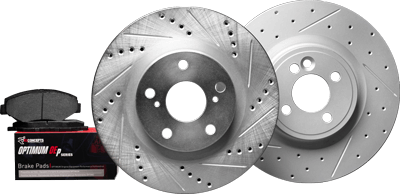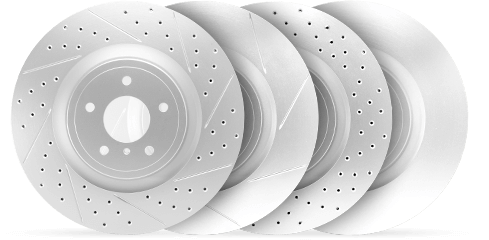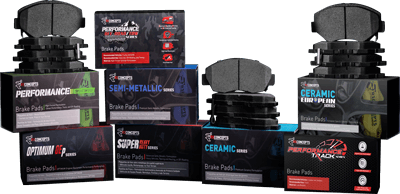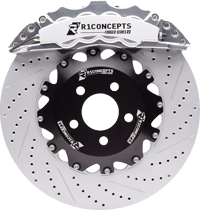Why is your brake caliper making noise? If you hear noises like squeaking, grinding, or clunking from your brakes they’re a signal potential safety issues.
The brake calipers is an essential part of your brake system, they provide the same value as the brake disc and brake rotors. If any of those parts will get an issue, it could result into failing brakes, causing serious issues. So it is crucial to address any issue you can see (or hear) in order to ensure your brake system operates correctly.
This guide made by R1 concepts will help you find the cause and solve the noise from your brake calipers so that you can continue to go with your vehicle.
Key Takeaways
Brake caliper noises, including squeaking, clicking, grinding, and clunking, are often indicators of underlying issues such as worn brake pads, seized pistons, or loose components, which can compromise safety and require immediate attention.
Diagnosing brake caliper noise starts with identifying the specific type of sound and its location—front, rear, left, or right calipers—to accurately pinpoint the problem and determine the appropriate fix.
Regular inspection and maintenance of brake calipers are crucial for ensuring their optimal function. This includes checking for visual signs of wear, confirming the movement and lubrication of components, and assessing brake pad condition to prevent noise and maintain safety.
What Does A Bad Caliper Sound Like?
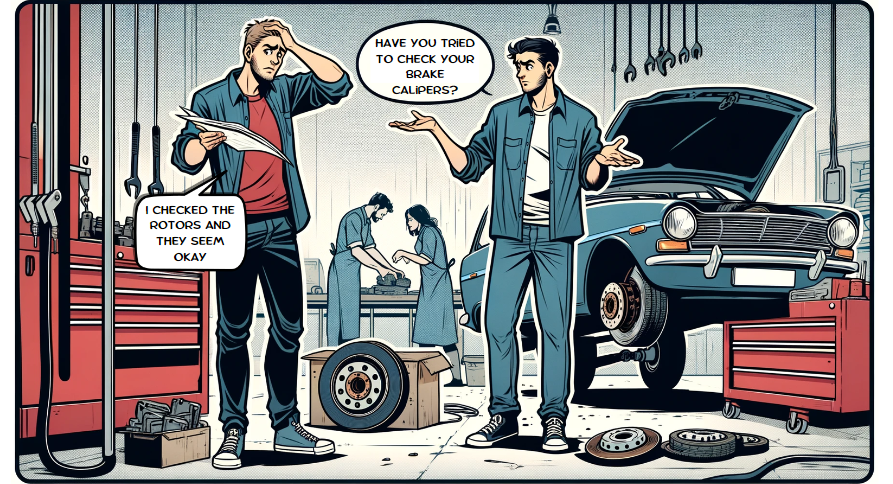
The first thing you may ask, especially when you are new to cars, is what does a bad caliper sound like? A bad caliper often starts with a dragging sound, which often creates a rubbing sound coming from your wheels. Eventually, especially when neglected, it could lead to anything from squeaking, grinding, clicking, and clunking, all of which indicate different causes.
Brake Caliper Noise And Reasons
To know the causes of why your brake calipers are noisy, the best thing to know first is the type of noise the brake caliper is making. We have a break down below.
Squeaking Noises
Are you hearing a squeaky brake noise somewhere on your calipers while braking? Most of the time, squeaky brakes could be because of a brake pad issue, where the brake pad edges are thin, causing metal-on-metal contact, but in some cases, a seized brake caliper is the culprit.
A seized brake caliper occurs when the caliper is unable to move freely, which can cause the brake pads to drag on the rotor and produce a squealing noise or screeching sound.
This seizing can happen due to corrosion, dirt and debris build-up, or lack of lubrication on the caliper’s sliding pins. Over time, the caliper piston can also become stuck due to rust or a failure of the rubber boot that protects it, leading to uneven brake pad wear and reduced braking efficiency.
Clicking Noises
A knocking sound indicates a damaged or loose brake caliper.
When there is looseness in the brake components like pads and calipers, it can result in bouncing movements which produce knocking noises during braking.
Similarly, if any brake parts that are worn-out or loosely attached due to damage over time, then this could lead to similar sounds when applying pressure on the brakes.
Grinding Noises
Metal-on-metal contact: Metallic grinding noises from your brake calipers are often a tell-tale sign of metal-on-metal contact, which usually occurs when the brake pads have worn down completely. This allows the caliper and the rotor to rub against each other, creating a distinct grinding sound that can’t be ignored.
Seized or Sticking caliper piston: another common culprit for grinding noises is a seized or sticking caliper piston. When your calipers don’t release after you let go of the brake pedal, it can cause a grinding sound due to them being stuck. This can prevent the caliper from releasing properly, causing the pads to be pressed against the rotors at all times. Imagine a vice grip that’s clamped down and won’t let go – that’s what a stuck piston does to your brake pads, leading to constant friction and that unpleasant grinding noise.
Dirt in calipers: Lastly, debris caught in the caliper, such as small rocks or road grit, can imitate the sound of grinding when lodged between the brake pad and the brake rotor itself. It’s akin to a pebble stuck in your shoe – every step, or in this case, every brake application, you hear and feel something is not quite right.
Clunking Sounds
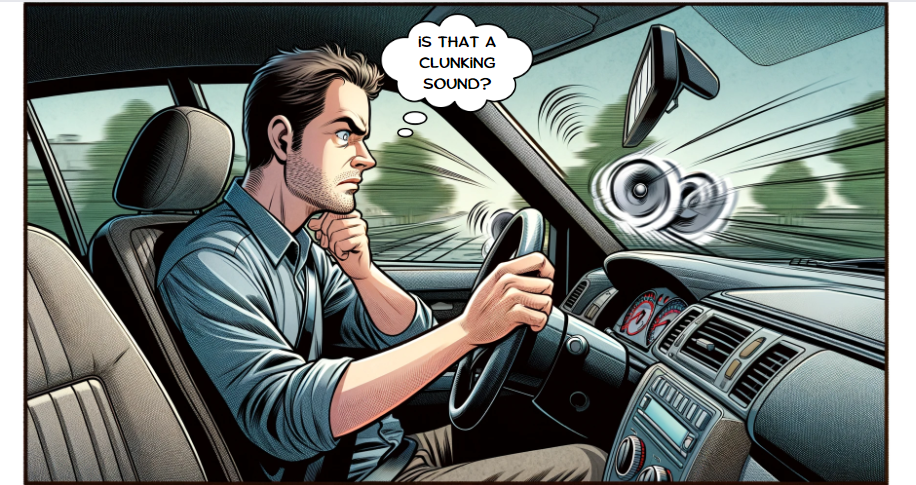
Clunking sounds in your braking system can indicate serious issues, such as:
Broken Caliper Piston: A broken piston can lead to metal-to-metal contact with disc brake itself, creating clunking noises. This is often a result of the piston failing to retract, which causes the brake pads to remain in contact with the rotors.
Loose Caliper Guide Pins: Loose caliper bracket pins can cause the caliper to move and make noise during braking. This movement may not seem significant, but even a small amount of play in the brake caliper assembly can lead to noticeable noise and potentially affect the stability and effectiveness of your braking system.
Worn Caliper Bushings: Worn-out bushings may result in the caliper moving excessively, which can produce clunking noises. This can be particularly noticeable during sudden stops or when navigating rough roads, as the caliper’s excessive movement translates to a knocking sound that can be felt in the pedal and heard from the wheel well.
Determine The Noise’s Location
After determining what type of noise you are hearing from your calipers, it is best to note to determine where the noise is coming from.
By pinpointing the exact location, whether it’s the front or rear brakes, or the left or right side, you can narrow down the potential causes and focus your troubleshooting efforts more effectively.
This initial step is crucial in the diagnostic process, as it can save you time and ensure that you address the correct part of your vehicle’s braking system.
Identify The Severity of the Noise
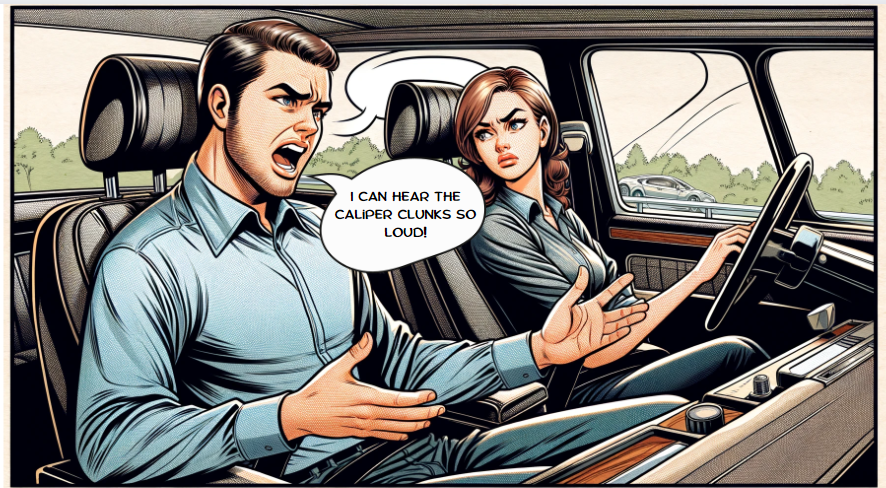
The next important factor to consider is how severe it is. The louder the noise, the more serious the issue your brake caliper is facing.
for example, a squealing brake noise, that starts off quietly but progressively gets worse could mean there’s an issue with your seized brake calipers wearing down your already old/worn-out brakes at an accelerated rate, which will inevitably result in complications for you later on.
Ignoring these loud noises can lead to potentially catastrophic consequences if not addressed promptly.
Solutions to Brake Caliper Problems
Metal-on-Metal Contact
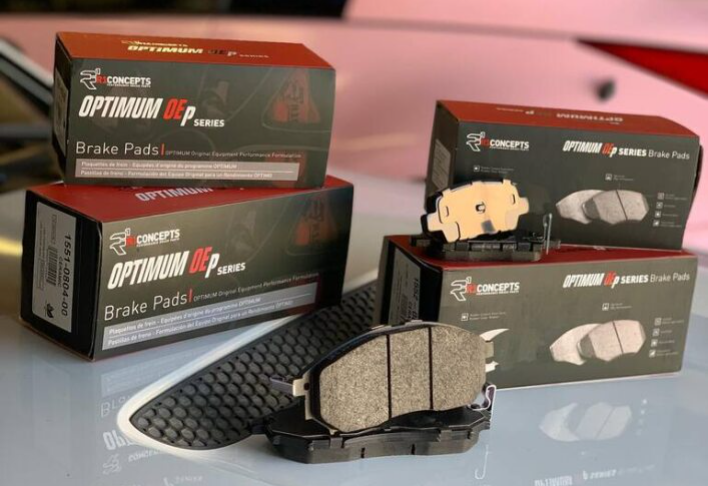
A metal-on-metal contact is typically a brake pad problem.
New brake pads will provide a fresh surface that interacts appropriately with the brake rotor, eliminating the grinding noise and restoring effective braking. When opting to change your brake pads, make sure that you will use the best brake pads in the market that provides longer life span and efficient brake power.
If just in case you need to change a brake pad set other than you brake pad sets, you can opt for the best brake kits in the market for great deals.
Seized Caliper Piston
A seized caliper piston can often be remedied by either rebuilding or replacing the caliper.
you can fix a seized caliper piston by disassembling the affected parts, cleaning them thoroughly to remove any rust or debris, and replacing any damaged seals. In some cases, the piston itself may need to be replaced.
Dirt in Calipers
Remove the caliper from the vehicle and clean it using a brake cleaner spray and a soft brush. Pay special attention to the sliding surfaces and the piston area. If necessary, disassemble the caliper to clean internal components. Reassemble with proper lubrication on the sliding pins.
Broken Caliper Piston
A broken caliper piston will require a complete caliper overhaul or replacement. It’s crucial to address this issue promptly to avoid further damage to the braking system and ensure safety on the road.
Damage in Brake Caliper
Inspect the caliper for any signs of physical damage such as cracks or leaks. If the caliper body is damaged, it is recommended to replace the entire caliper assembly to prevent brake failure.
Loose Caliper Guide Pins
Tighten or replace the caliper guide pins as needed. If the guide pins are corroded or damaged, they should be replaced and lubricated to ensure smooth operation.
Worn Caliper Bushings
Inspect the caliper bushings for wear or damage. Replace any bushings that show signs of deterioration to prevent excessive caliper movement and ensure proper brake function
Step-By-Step Brake Caliper Inspection
At this stage, you should be able to easily recognize the various types of noises that can come from brake calipers and know where they are located on a vehicle.
Now it’s time to learn another crucial skill: inspecting your brake calipers for any potential noise-related problems. Here’s our step-by-step guide on how to do the inspection properly:
Safety First: Before you begin, ensure your vehicle is parked on a level surface, the parking brake is engaged, and the engine is off. It’s essential to make sure the vehicle won’t move or roll while you’re working on it, as this could lead to injury or further damage to your vehicle.
Wear safety glasses and gloves for protection. Safety glasses will help protect your eyes from any potential flying debris or dust, particularly when you’re working with tools close to your face. Gloves are important for maintaining a good grip on your tools and protecting your hands from sharp edges and the heat of the brake components.
Gather Tools: You’ll need a few basic tools such as a jack, jack stands, a lug wrench, and possibly a set of socket wrenches.
A flashlight or work light can also be helpful to illuminate the work area, especially if you’re working in a dimly lit garage or if you need to peer into the tight spaces behind the wheels.
Loosen Wheel Lug Nuts: Before lifting the vehicle, use the lug wrench to slightly loosen the lug nuts on the wheel where you’ll be inspecting the brake caliper.
Lift the Vehicle: Use the jack to lift the vehicle at the appropriate jacking point (refer to your vehicle’s manual). Once lifted, secure the vehicle with jack stands for safety.
Remove the Wheel: Finish unscrewing the lug nuts and remove the wheel to expose the brake caliper and rotor.
Inspect the Brake Caliper: Look for any visible signs of damage or wear on the caliper. Check for leaks, any fluid leak especially around the piston area. Leaking brake fluid can indicate a faulty caliper seal.
Quick guide for inspecting brake calipers:
Metal-on-Metal Contact:
Inspect the brake pads and rotor. If you see excessive wear on the rotor or if the brake pads are worn down to the metal, this indicates metal-on-metal contact.
Look for shiny spots or grooves on the rotor, which suggest the caliper is not releasing properly, causing the pads to rub against the rotor continuously.
Seized Caliper Piston:
Check if the brake pad on one side of the rotor is wearing faster than the other. This could be a sign that the piston is not retracting properly.
Look for signs of rust or corrosion around the piston area, which can cause seizing.
Dirt in Calipers:
Examine the caliper for excessive dirt, grime, or brake dust buildup.
Pay attention to the area around the piston and the sliding surfaces; dirt here can impede proper caliper movement.
Broken Caliper Piston:
Inspect the piston for any visible cracks or damage.
Check for brake fluid leakage around the piston, as this can indicate a broken or damaged piston seal.
Damage in Brake Caliper:
Look for physical damage such as cracks, dents, or warping in the caliper body.
Inspect for any signs of brake fluid leakage, which could suggest damage to the caliper seals or bore.
Loose Caliper Guide Pins:
Wiggle the caliper gently to check for excessive play, which can indicate loose guide pins.
Examine the guide pins for signs of wear, corrosion, or lack of lubrication.
Worn Caliper Bushings:
Check the bushings (if applicable) for signs of wear, cracking, or deterioration.
Look for uneven wear on the brake pads, which can be a sign of worn bushings causing the caliper to misalign.
Check Caliper Movement: Brake calipers should slide smoothly on their guides. Check if the caliper moves freely when pressure is applied and released. If it’s sticking or not moving smoothly, it may need cleaning, lubrication, or replacement.
Examine Brake Pads and Rotor: While you’re there, inspect the brake pads for uneven wear, and the rotor for any grooves or uneven wear. Noise can sometimes be caused by worn worn out brake pads or a damaged rotor.
now, based on the issues you’ve identified, proceed with the appropriate solutions provided in the following section.
Taking Action After Inspection
Once you’ve completed the inspection of your brake calipers and identified the type of noise and its potential causes, it’s crucial to take note of your findings.
If you’re confident in your mechanical skills and have the necessary tools, you may be able to perform the recommended fixes yourself. This could include replacing worn brake pads, lubricating sliding pins, or even overhauling a caliper if needed.
However, if the issues are more complex or you’re unsure about tackling them on your own, it’s wise to seek the assistance of a professional mechanic. They can provide a more thorough diagnosis and ensure that any repairs are carried out safely and correctly.
Remember, the braking system is critical for your safety on the road, so it’s important to address any issues promptly and effectively.
Can I Fix My Brake Caliper By Myself?
Yes, it is possible to fix brake calipers by yourself, but it depends on your skills and ability. Some issues will require help of a professional mechanic in order to fix.
Frequently Asked Questions
What are the estimated costs of repair of brake calipers?
The cost to repair a brake caliper can vary greatly depending on the vehicle make and model, as well as the extent of the damage. Typically, you can expect to pay anywhere from $100 to $400 per caliper. This price includes both parts and labor, with the parts themselves ranging from $50 to $150 each. It’s important to get a detailed quote from your mechanic, as additional services such as brake pad replacement or rotor resurfacing may also be needed.
Are there any safety risks associated with driving with a noisy brake caliper?
Yes, driving with a noisy brake caliper can pose significant safety risks. The noise may indicate a serious issue such as a seized caliper or excessively worn brake pads, which can reduce braking efficiency and increase stopping distances. In extreme cases, it could lead to brake failure. It is crucial to address any bad brake caliper noises promptly to ensure your vehicle remains safe to operate.
How can I prevent brake caliper noise in the future?
Preventing brake caliper noise involves regular maintenance and inspections. Ensure that your brake pads and rotors are checked periodically for wear and replaced when necessary. Keeping the caliper and related components clean and well-lubricated can also prevent noise. Additionally, avoid hard braking when possible, as this can cause excessive wear and tear on the braking system.
Can a noisy brake caliper cause other problems with my car?
A noisy brake caliper can indeed lead to other problems with your car. If the caliper is not functioning properly, it can cause uneven brake pad wear, which in turn can warp the brake rotors, and lead to a bumpy or shaky driving experience. Furthermore, a malfunctioning caliper can strain the brake system, potentially causing damage to other components and leading to more extensive and costly repairs.


